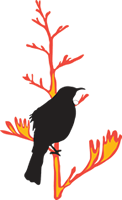Alpine Scree Weta Deinacrida connectens Of the eleven species of New Zealand giant weta, Deinacrida connectens Ander is the only species not totallyprotected by legislation. This species is found onscree slopes between 1200 m and 3600 m above sealevel throughout the South Island of New Zealandfrom the Arthur Range in North West Nelson tothe Takitimu Range in Southland. Over this range the species shows a great deal of colour variation. For example, the extent of red covering the pronotum ranges from 90-15%, and the background colour of tergites varies from blue grey to olive to brown to black. Often the scree weta is coloured to match the rock type of the scree in which it lives, with darker individuals found only in populations in the far south and west of their range. Seven karyotypes are described within Deinacrida connectens, with diploid numbers ranging from 2n= 17(XO) to 2n =22(XX). Nuclear genetic diversity shows a pattern of isolation by distance (Morgan-Richards & Gibbs 1996), but mtDNA sequences revealed little gene flow. We found that several scree weta population samples on mountain ranges had their own reciprocally monophyletic, deeply differentiated lineages. Corrected genetic distance among lineages was 8.4% (K2P) or 13% (GTR ). We propose a model to explain this phylogeographical structure, which links the radiation of D. connectens to Pliocene mountain building, and maintenance of this structure through the combined effects of mountain-top isolation during Pleistocene interglacials and ice barriers to dispersal during glacials (Trewick et al. 2000).
|
|

